TWO-STROKE TEST: WHAT IT’S LIKE TO RIDE THE KX500 BEAST
Click on images to enlarge
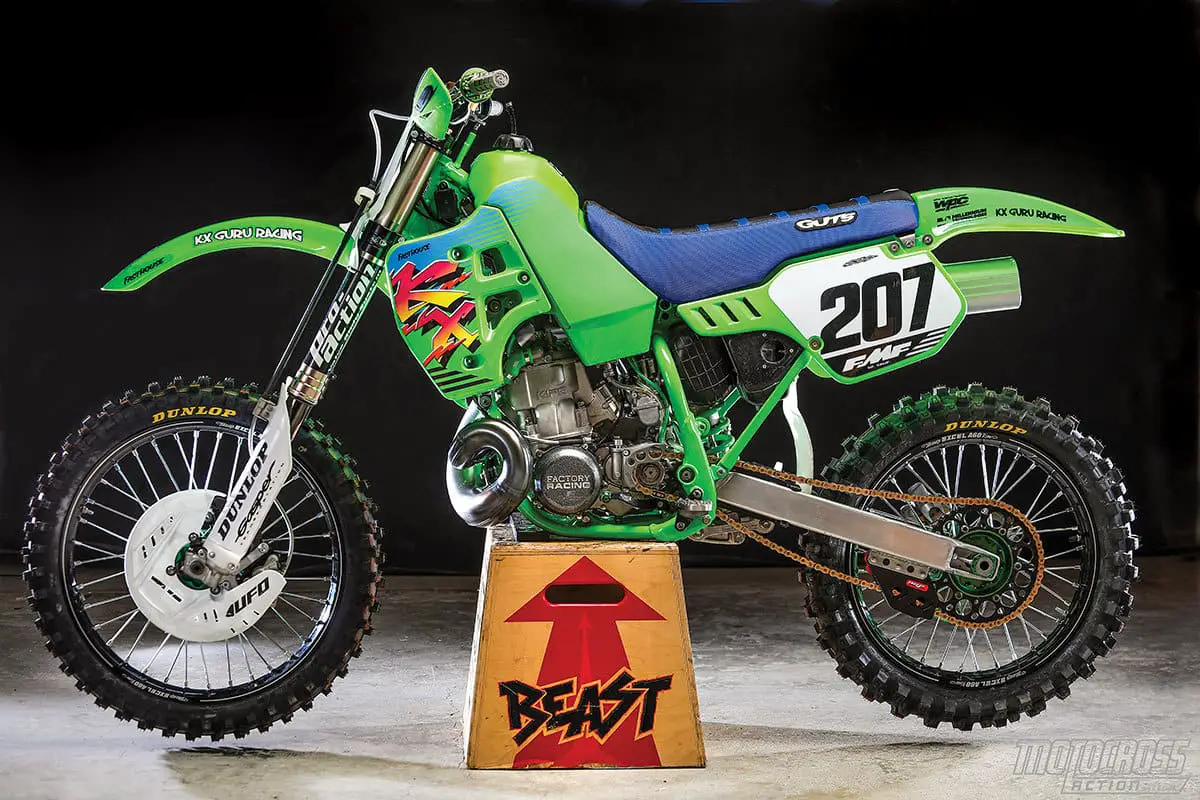 Sean Collier single-handedly turned the venerable Kawasaki KX500 into the restoration bike of the last five years. So, it was a little surprising to find Sean at the 2017 World Two-Stroke Championship on a TM 300MX. He had the flu and elected to race the less powerful TM to conserve energy for the race.
Sean Collier single-handedly turned the venerable Kawasaki KX500 into the restoration bike of the last five years. So, it was a little surprising to find Sean at the 2017 World Two-Stroke Championship on a TM 300MX. He had the flu and elected to race the less powerful TM to conserve energy for the race.
The Kawasaki KX500 has become the motocross version of fine wine—it gets better with age. With its official retirement in 2004, and without any significant updates since 1992, the KX500 has had 25 years to ferment. In truth, as far back as 1992, nobody—and we mean nobody—ever thought the KX500 would get a second wind. Now, two decades later, it seems everybody wants a taste of the KX500’s nectar. Why? There are a few reasons, but let’s go over some numbers first.
The 1992–2004 model weighed 220 pounds. That is lighter than all the 2017 250Fs, save for the KTM 250SXF, which comes in at 218 pounds. You have to admit, the bulky KX500, with twice the displacement of the 250 four-strokes, looks a lot heavier than it really is. How about the power numbers? In stock trim the KX500 makes in the realm of 63 horsepower and has 40-plus foot-pounds of torque. It is a lighter bike than the new-aged 250Fs and more powerful than all of the 2017 450 four-strokes. Sounds good on paper, doesn’t it?
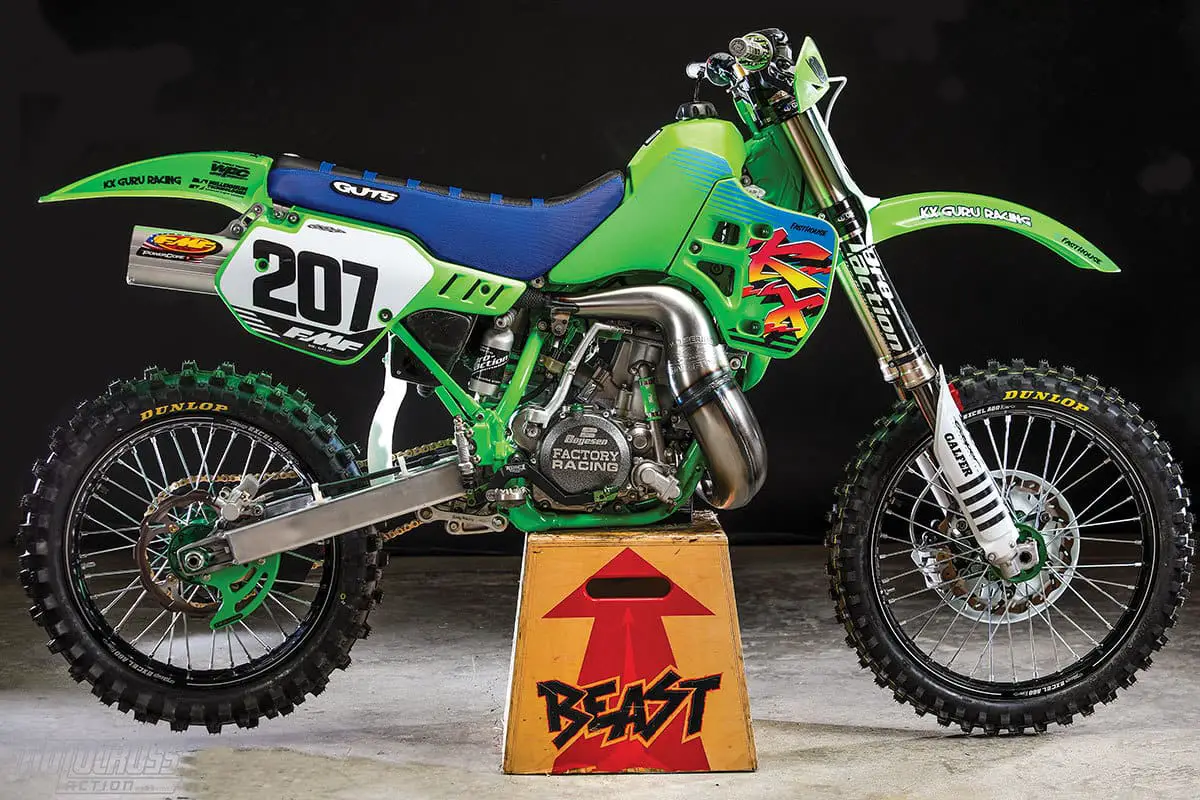
So why was it the poor second cousin to the Honda CR500 back when they were both new? On top of the odd, strange, screwy, unusual bodywork of the KX500, nobody wanted to ride it because it wasn’t cool. Okay, maybe the breakneck power scared many off. Or, was it the barbaric handling, ill-cornering, Flintstone-braking or violently vibrating chassis? Most old-school 500cc motocross racers chose the CR500’s handling and overall package over the KX500. There is no doubt that the KX500 bike wasn’t given the respect, nor development, it deserved.
A DECADE AGO, YOU COULDN’T GIVE AWAY A KX500. NOW, PEOPLE ARE GOING TO THE DARK CORNERS OF THEIR SHEDS AND DUSTING THE COBWEBS OFF THEIR ANCIENT GREEN BEASTS. IN MXA’S OPINION, THE BIKE STILL LOOKS (THERE IS NO POLITE WAY TO SAY THIS) UGLY.
Is Kawasaki to blame? To some extent, yes, because Kawasaki built it. How about the AMA for axing the 500cc class in 1993? The AMA acquiesced to Honda’s and Suzuki’s demands to kill the the class. Are you to blame? You probably were not racing during the heyday of the 500cc two-stroke era, so you are guilt-free. Is MXA to blame? We didn’t have much good to say about the KX500—other than that its engine was superior to that of the Honda CR500. In the end, Kawasaki lost faith in the KX500. They stopped spending R&D money on it and didn’t want MXA to test it, even though Kawasaki still sold it. And, for our part, we didn’t want to waste our time testing a bike that was stuck in the Paleozoic Era.
 Luckily, there MXA wrecking crew still has a few test riders old enough to have raced big bore two-strokes from the era of the CR500 and KX500. They felt right at home on The Beast.
Luckily, there MXA wrecking crew still has a few test riders old enough to have raced big bore two-strokes from the era of the CR500 and KX500. They felt right at home on The Beast.
A decade ago, you couldn’t give away a KX500. Now, people are going into the dark corners of their sheds and dusting the cobwebs off their ancient green beasts. In MXA’s opinion, the bike still looks (there is no polite way to say this) ugly. But, suddenly, the bike is in with the in-crowd. It is cool to own one. Why the sudden change in fortunes? What makes a bike that wasn’t well received when it was brand new suddenly the belle of the ball? The answer? Sean Collier. Sean was a very talented AMA Pro, but things didn’t pan out the way they should have. Life, injuries and other variables forced Sean to give up the dream and take a blue-collar job; however, Sean never gave up his passion for racing. He always showed up at the big local events with surplus talent on tap. He would win the 2013 and 2014 World Two-Stroke Championships, albeit on a Yamaha YZ250. As for his KX500 connection, his dad had an old Kawasaki KX500 that Sean grew fond of—on and off the track. Dad and son made the decision to break out the KX500 and turn it into Sean’s new steed. It was a match made in heaven. When you watch Sean aboard “The Beast,” you see poetry in motion. It looks like he isn’t even trying. Sean’s races on the KX500 attracted attention, publicity and an ardent following of riders who wanted to emulate him.
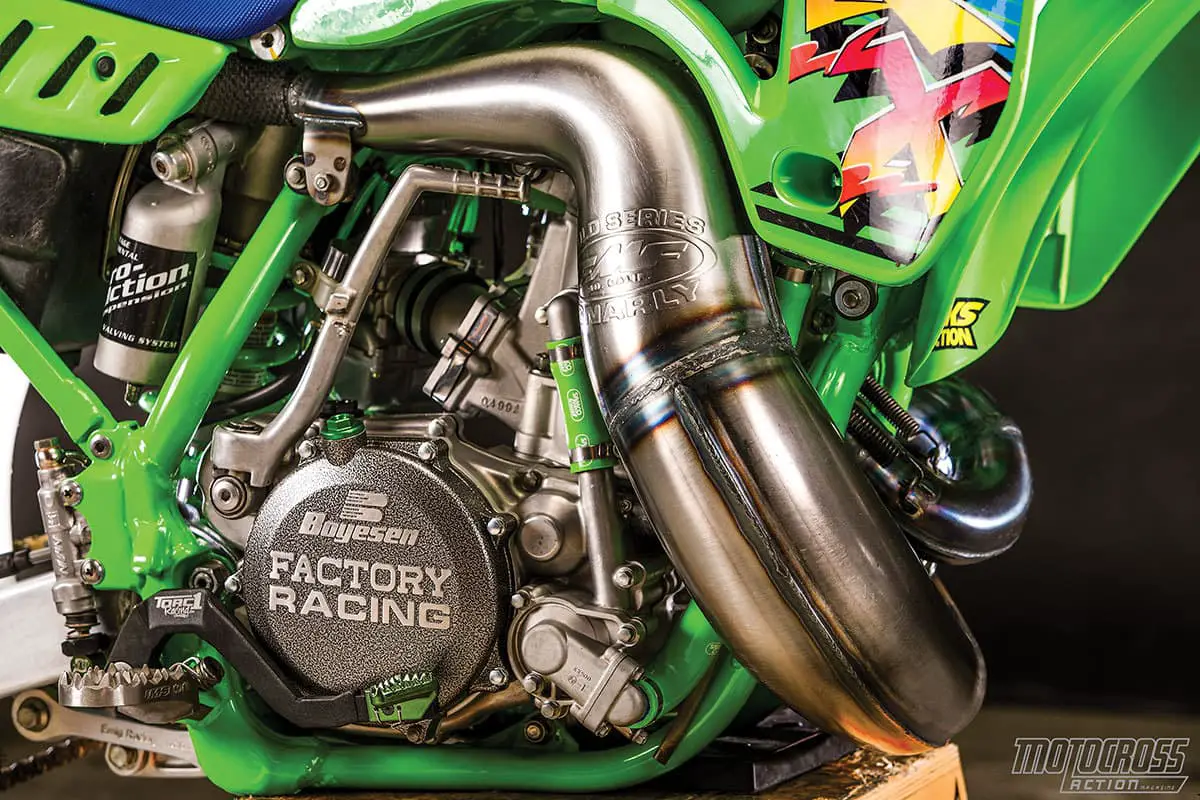
In 2015 MXA tested Sean’s—well, actually his dad’s—1997 Kawasaki KX500. It was an over-the-top build with Showa SFF air forks, KX450F wheels and brakes, and a 66-horsepower engine built by C4MX. Sean dropped the hammer on this bike by holeshotting every 450 four-stroke he lined up next to and won races against top-level riders on it. The best way to describe riding Sean’s 1997 Kawasaki KX500 was that it was like riding a wild bull. Not that any of us have ever been aboard a bull, but even a rodeo rider would be impressed in the saddle of Sean’s “Beast.” It was scary! It had a mind of its own. When the rear end kicked, it went left when you thought it would go right. The vibration made you Loctite bolts that never come loose on other bikes. Turning the throttle felt like pulling the red handle on an F-18 ejector seat. It was an adrenaline junky’s dream.
Sean knew the shortcomings of the KX500, but he still believed in it. So, he went looking for the Kawasaki version of the horse whisperer—a man who could make a KX500 appealing to the average rider instead of guys with death wishes. Sean found that man in Oscar Cota from KX Guru Racing. Oscar and his team (who all ride KX500s as their personal bikes) never gave up on the bike and worked in close proximity with the Kawasaki factory Baja team back when they raced KX500s. Oscar believed that he could build Sean a KX500 that didn’t vibrate, didn’t break and would handle better. Sean had a stock 2002 KX500 in his garage as a back-up bike. Oscar Cota took this bike and stripped it to the frame, gusseted the weak spots, shimmed the gaps between the motor mounts and powdercoated the rebuilt frame kiwi green to match the plastic color.
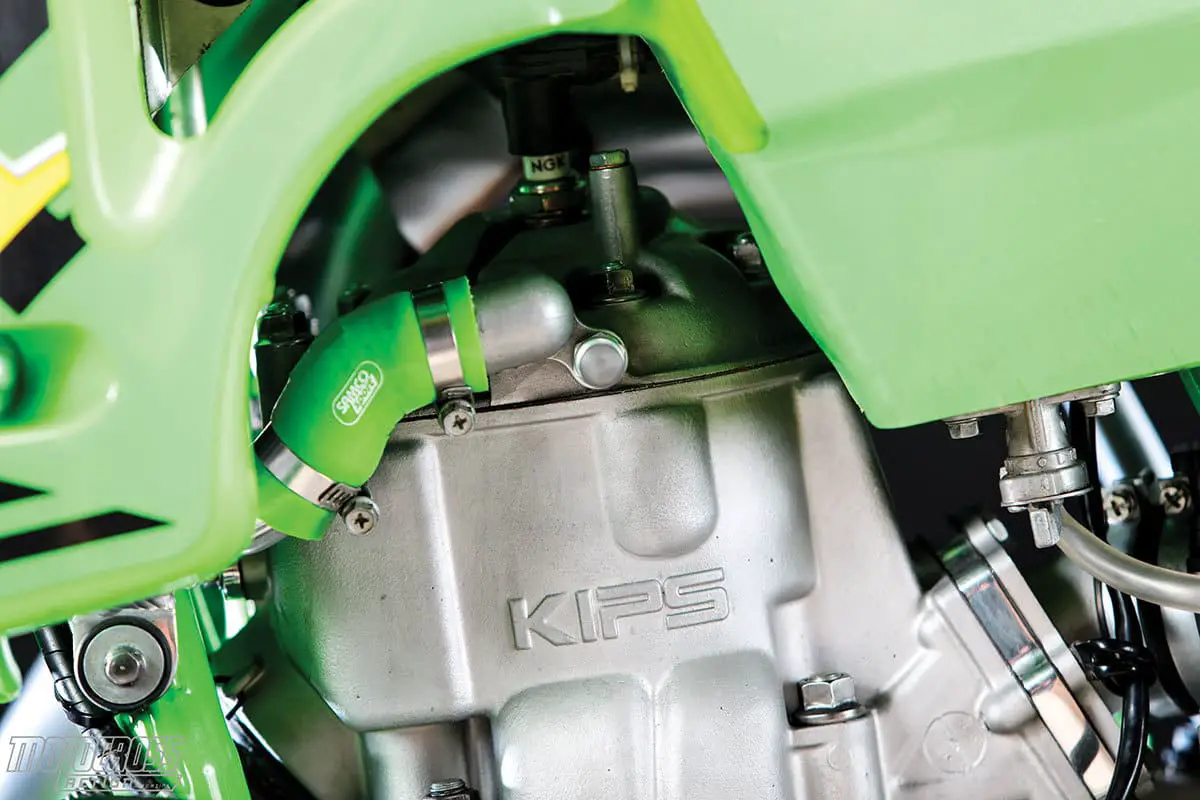
As for the engine, Sean wanted all bottom to mid. He prefers to ride a gear high and chug the power around the track. Keeping his speed up and rolling on the throttle allowed Sean to save energy and tame the Beast. Oscar cut the head, lowered the port timing and backed the reed cage up with a spacer. The stock 39mm carburetor was replaced with a 38mm Keihin PKW carburetor from a 1997 Kawasaki KX250. FMF makes a woods pipe for the KX500 that has more bottom-end grunt, so Sean went with that pipe. To reduce vibration, the crank was static-balanced by hand with the piston assembly installed. The transmission was WPC micro-shot-peened to cut friction by 30 percent.
The finishing touches made to the engine were a custom-built compression release and a two-piece clutch cover. The decompression release borrowed chainsaw technology, but had to be installed delicately between the coolant passages of the head. Material was welded on and then cleaned and treaded. The compression release was then inserted. Before Sean kicks the bike to life, he presses the decompression button. When the bike starts, the button pops out automatically. In stock trim the KX500 has a one-piece clutch cover, which makes changing a clutch a real pain in the neck. KX Guru Racing cut the face off the stock KX500 cover and welded on an adapter ring that allows a KX450F clutch cover to bolt right on. This allows the clutch plate to be changed without removing the complete KX500 side case.
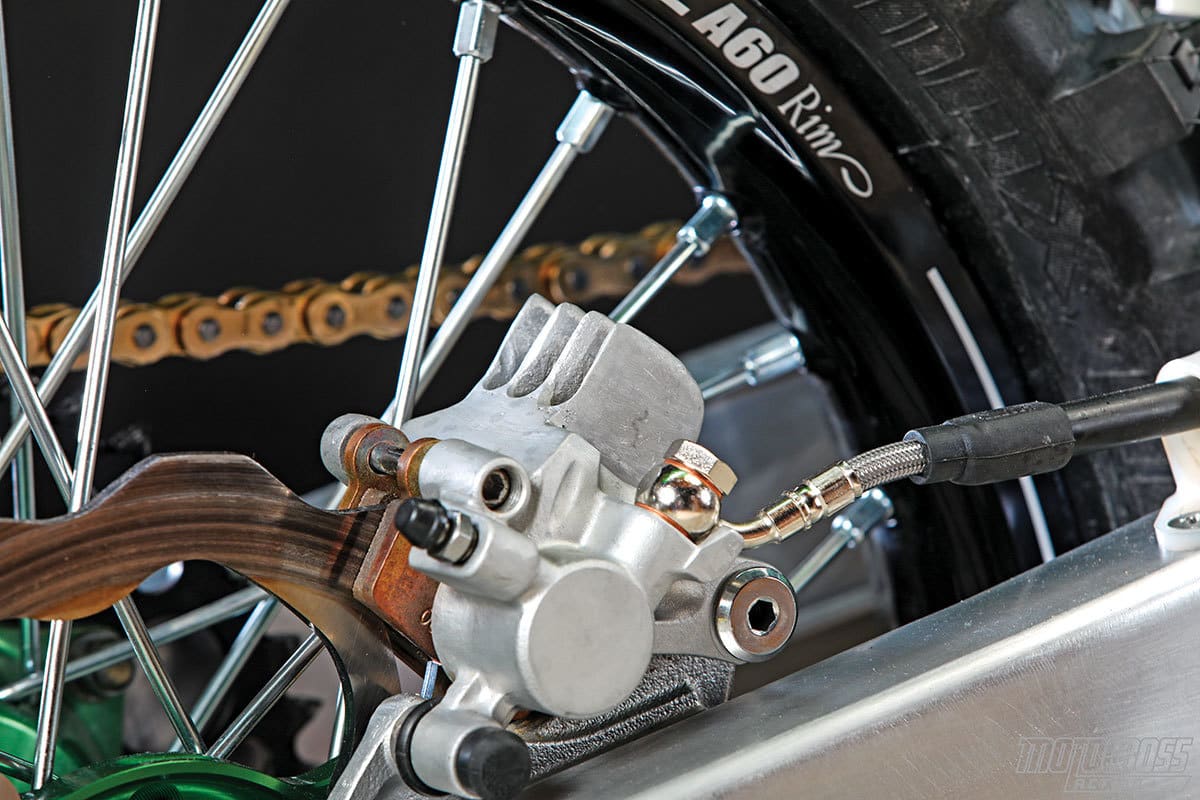
To bring the bike into the future, many parts from the KX450F were brought into the mix. Sean’s bike uses 2008 KX450F forks (they fit in the KX500 clamps with no alterations). These forks required a KX450F front-brake assembly and wheel. A KX450F rear wheel, with its larger rear axle and rear brake caliper, was used out back. The rims were built with Excel A60 rims and FasterUSA hubs. To help with rear-brake heat dissipation, a chunk of fins off an old ATK 406 head were fabricated onto the rear brake caliper to draw heat out.
The last piece of the puzzle was to get Sean’s new KX500 to handle like a modern machine rather than a tug boat. This was achieved by shortening the pull rods from 134mm to 132.5mm by repurposing an old Emig Racing link. This mod raised the rear of the bike to get more weight on the front end and steepened the head angle. The suspension was re-valved by Pro Action Suspension.
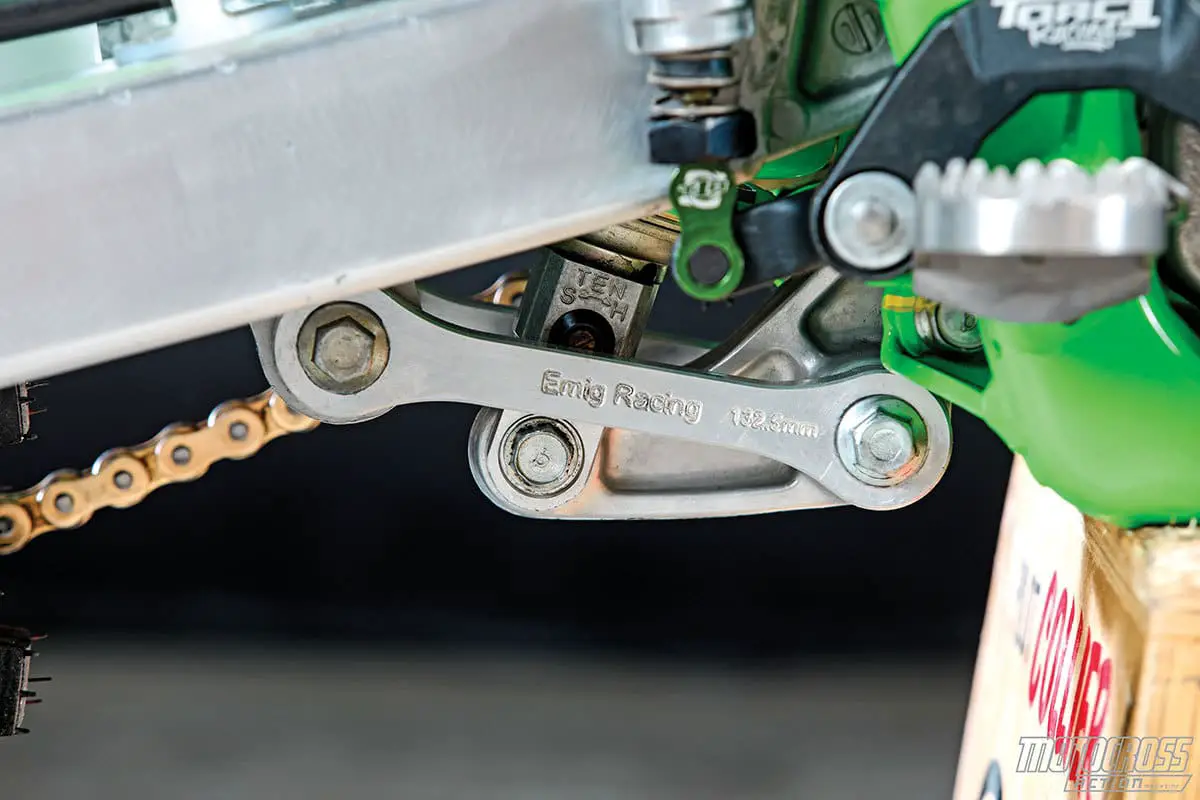
MXA wanted to gauge the KX Guru’s 2002 Kawasaki KX500 against Sean’s original 1997 KX500 that we tested two years ago, so we rode both bikes back to back to get a good gauge on the differences. First, we climbed aboard the KX Guru Racing KX500, but it was incredibly hard to kick over. It turns out that we forgot to press the compression-release button. The cockpit felt wide yet comfortable. The bars were cut down 1/4 inch on each side to give the bike a narrower feel. It took a few laps to get used to the two-stroke powerband. The engine only needed to be revved into the lower middle. We had to short-shift the Beast. There was a learning curve to riding a bike that ran so low in the powerband, but magic happened when we shifted early and rode a gear high. The abundant torque pulled a higher gear with ease, and you could literally chug around the track. It sounded like you were just putting around at half-throttle gas, but you were actually going amazingly fast. Turning the throttle in small increments was all you needed.
The bike was easy to ride, just as long as you kept it chugging. If you decided to go for broke, the KX500 could easily get away from you. The engine felt tight and didn’t have much vibration at the bars. From gear to gear, the transmission slid through the cogs with ease. Every MXA test rider was surprised with how well it handled. Some felt it handled as well as modern bikes. It was balanced end to end. The bike even cornered without much of a fight. It was no Suzuki, but our test riders had no complaints. It didn’t have a mind of its own like past KX500s — dating back to 1992. The suspension had a plush feel, and the rear was consistent each and every time we hit a bump.
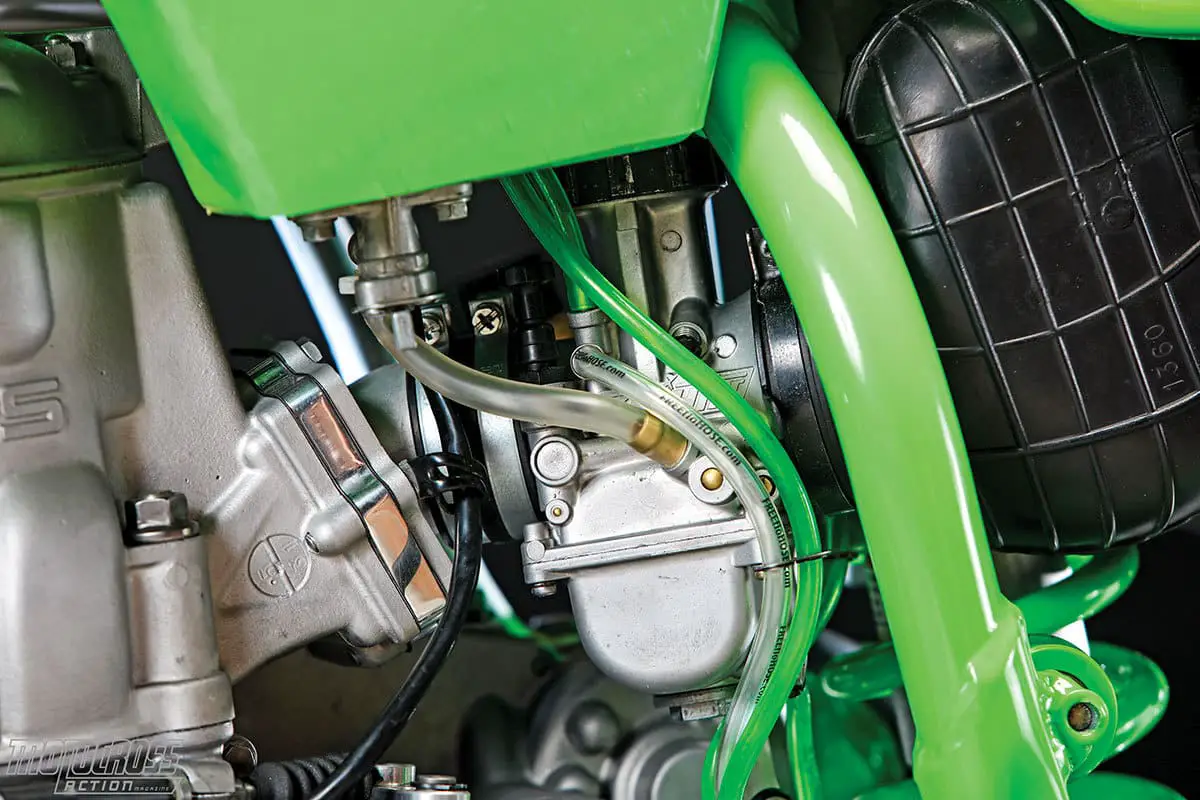
The proof would be in the comparison of Sean’s new bike against his old bike. What a shocker. Sean’s 1997 KX500 was a rocket ship without a guidance system. It had a very mellow bottom end, but once you hit the midrange, things started to happen — fast. The powerband had a mind of its own. Once it came on the pipe, you couldn’t meter it back down to manageable. You either shut off or hung on for the ride. On top of that, the rear end was incredibly busy as it dipped, rose and kicked to a rhythm all its own. The MXA test riders got flashbacks of the first time they rode Sean Collier’s Beast two years ago. There were mixed emotions about Sean’s 1997 KX500 because of how exotic it was, but nobody felt as safe riding it as they did Sean’s new Beast.
The KX Guru Racing KX500 was dialed in. It turned and handled well, had good power, superb brakes, and was more reliable. The only thing most MXA test riders would change, since we aren’t as fast as Sean Collier, would be to move the power up just a smidgen. This could be accomplished two ways: (1) Replacing the FMF Gnarly woods pipe with the motocross version of the KX500 Gnarly. (2) Taking a tooth or two off of the rear sprocket.
TURNING THE THROTTLE IN SMALL INCREMENTS WAS ALL YOU NEEDED. THE BIKE WAS EASY TO RIDE, JUST AS LONG AS YOU KEPT IT CHUGGING. IF YOU DECIDED TO GO FOR BROKE, THE KX500 COULD EASILY GET AWAY FROM YOU.

And there you have it. Have what? A 12-year-old beast of a bike that wasn’t highly rated by the motocross masses when it was brand new. Now, suddenly, it is in high demand. Blame it on Sean.
SEAN COLLIER’S KX500 BUILD LIST
www.kxguru.com
www.fmfracing.com
www.mt-llc.com
www.wpctreatment.com
www.dunlopmotorcycletires.com
www.torc1racing.com
www.rkexcelamerica.com
www.fasterusa.com
www.motorcycleradiators.com
www.imsproducts.com
www.galferusa.com
www.boyesen.com
www.pro-action.com
www.gutsracing.com
www.ufoplasticusa.com
www.factory-mx.com
www.worksconnection.com
www.pivotworks.com
www.cometic.com
www.ride-engineering.com
www.samcosport.com
www.tmdesignworks.com
www.twinair.com
IF YOU SUBSCRIBED TO MXA YOU WOULD HAVE READ ALL ABOUT IN THIS ISSUE
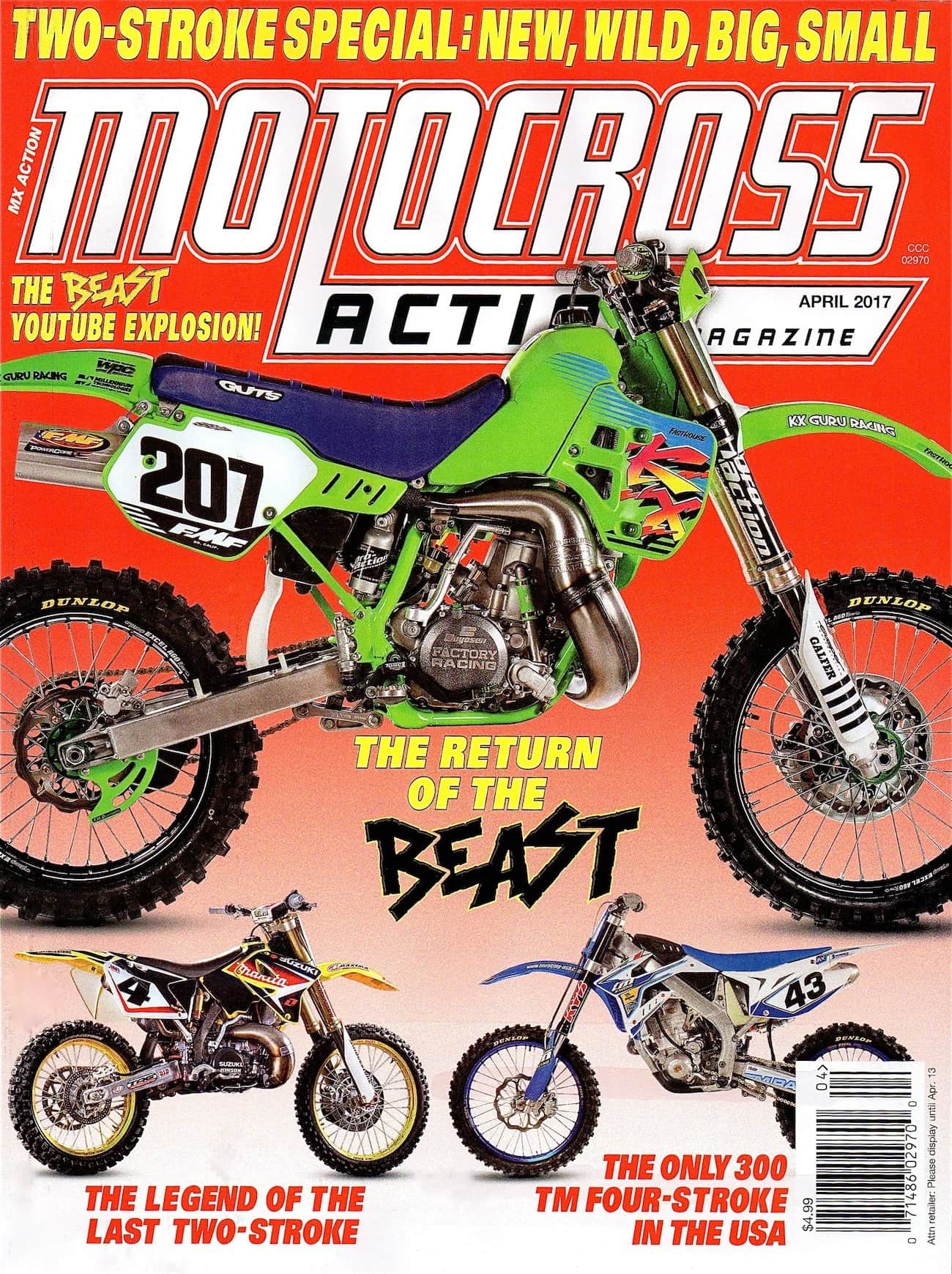









Comments are closed.